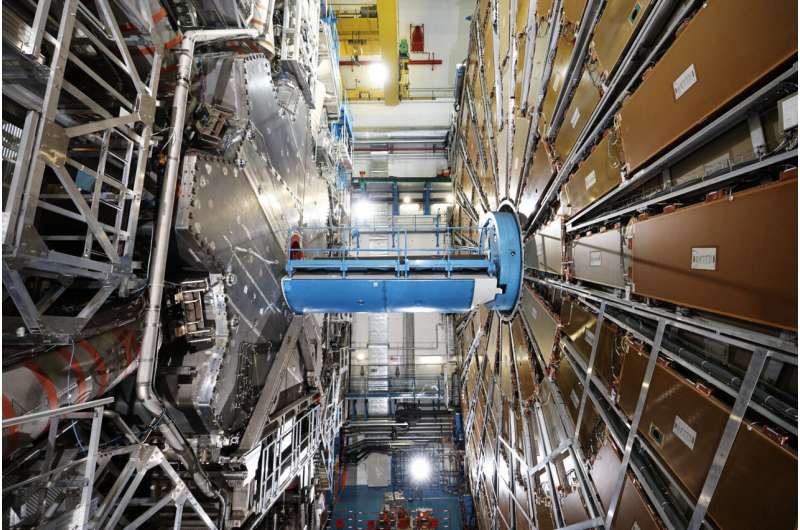In collisions between protons at the Large Hadron Collider (LHC), pairs of top quarks—the heaviest known elementary particles—are frequently produced along with other heavy quarks, including bottom and charm quarks. These collision events can provide physicists with valuable insights into quantum chromodynamics (QCD), the theory that describes the strong force. Precisely determining the production rates (or “cross-sections”) of these processes also enables researchers to more effectively distinguish them from rarer phenomena.
In two recent studies, the ATLAS collaboration analyzed proton–proton collision data from LHC Run 2 (2015–2018) to measure how often top-quark pairs are produced alongside bottom quarks or charm quarks and to explore the detailed dynamics of these processes.
The first ATLAS study focused on how often top-quark pairs are created along with “jets” of particles produced by bottom quarks (b-jets). To identify (or “tag”) these b-jets with high accuracy, researchers used tools called flavor-tagging algorithms, which look for specific patterns, such as how far through the ATLAS detector particles traverse before they decay.
By analyzing events with opposite-charge electron–muon pairs and at least three or four b-jets, ATLAS physicists made the most precise measurements to date of the total cross-sections of this top-quark-pair process in these event categories. These measurements surpass the accuracy of current theoretical predictions, especially in events with higher numbers of b-jets. The results were compared to multiple theoretical predictions to assess the accuracy of the modeling of this process.
The researchers also examined motional (or “kinematic”) properties, such as the momenta of the b-jets and the total jet energy, to test how well simulations of top-quark-pair production match the data. Their findings point to areas where theoretical models need improvement to better capture the complexities of additional b-jet production.
The second ATLAS study, presented recently at the 17th International Workshop on Top Quark Physics, broke new ground by providing the first dedicated ATLAS measurement of how often top-quark pairs are produced along with jets originating from charm quarks (c-jets).
ATLAS physicists analyzed events with one or two leptons (electrons and muons), using a custom flavor-tagging algorithm developed specifically for this study to distinguish c-jets from b-jets and other jets. This algorithm was essential because c-jets are even more challenging to identify than b-jets, as they have shorter lifetimes and produce less distinct signatures in the ATLAS detector.
The study found that most theoretical models provided reasonable agreement with the data, though they generally underpredicted the production rates of c-jets. These results, which for the first time separately determined the cross-sections for single and multiple charm-quark production in top-quark-pair events, highlight the need for refined simulations of these processes to improve future measurements.
Taken together, these studies deepen the understanding of the top quark’s relationship with bottom and charm quarks within the framework of QCD. In addition, they pave the way for new explorations of rarer processes involving top quarks—such as the simultaneous production of four top quarks—that could push the boundaries of known physics.
Both studies are published on the arXiv preprint server.
More information:
ATLAS Collaboration, Measurement of tt¯ production in association with additional b-jets in the eμ final state in proton-proton collisions at s√=13 TeV with the ATLAS detector, arXiv (2024). DOI: 10.48550/arxiv.2407.13473
ATLAS Collaboration, Measurement of top-quark pair production in association with charm quarks in proton-proton collisions at s√=13 TeV with the ATLAS detector, arXiv (2024). DOI: 10.48550/arxiv.2409.11305
Journal information:
arXiv
Citation:
Decoding top quarks with precision: Experiment at Large Hadron Collider reveals how pairs of top quarks are produced (2024, October 16)
retrieved 17 October 2024
from https://phys.org/news/2024-10-decoding-quarks-precision-large-hadron.html
This document is subject to copyright. Apart from any fair dealing for the purpose of private study or research, no
part may be reproduced without the written permission. The content is provided for information purposes only.

